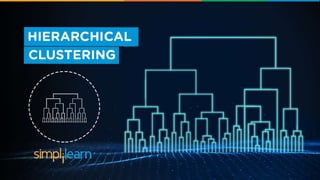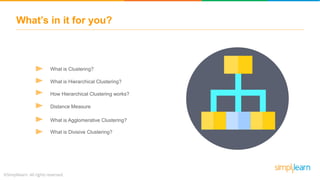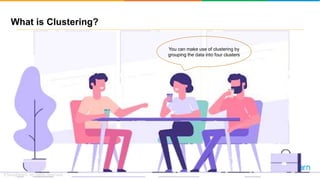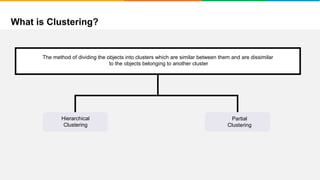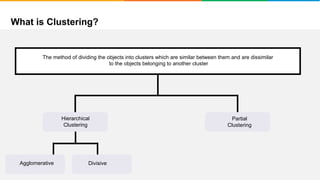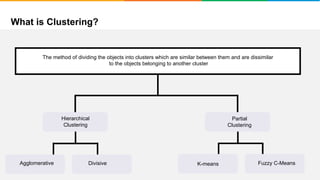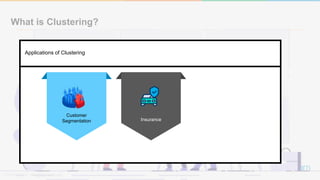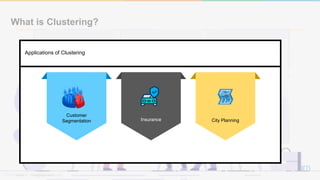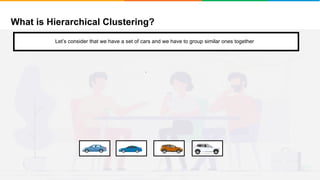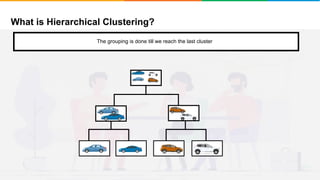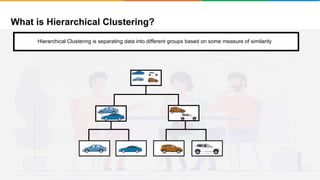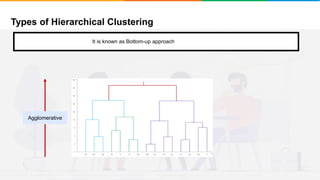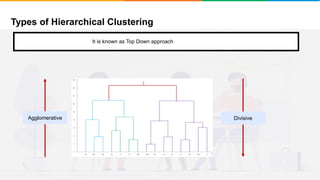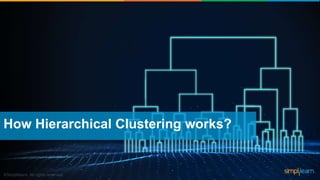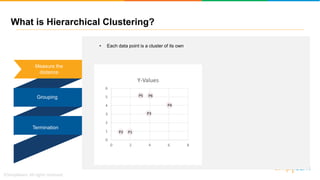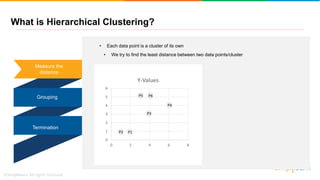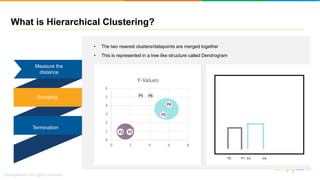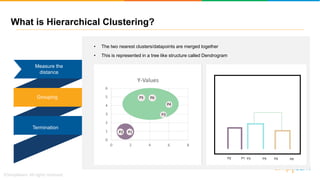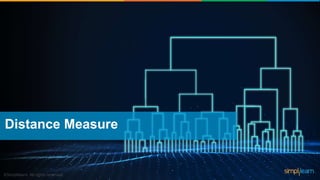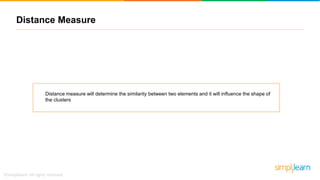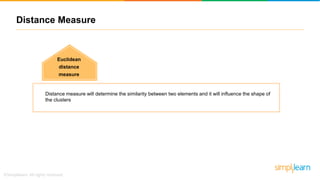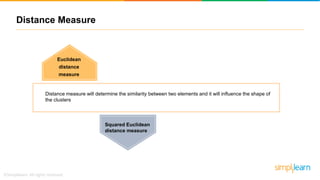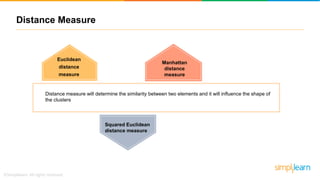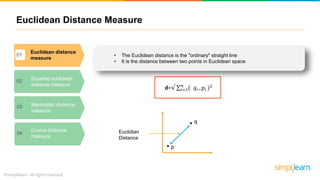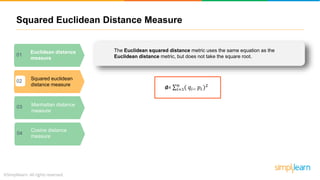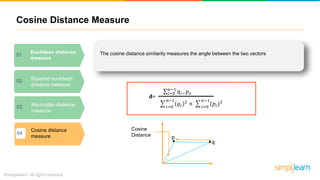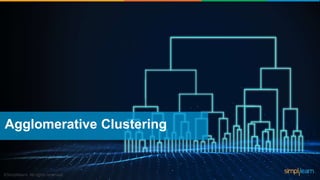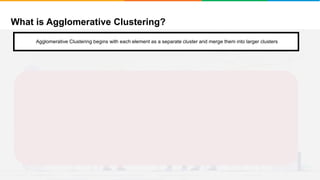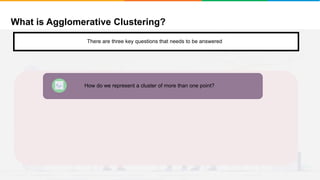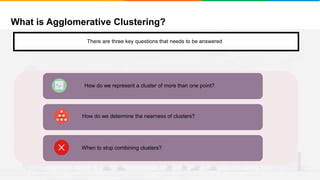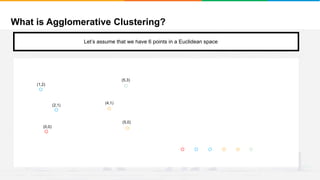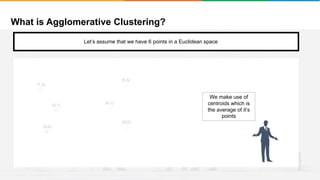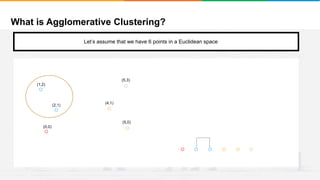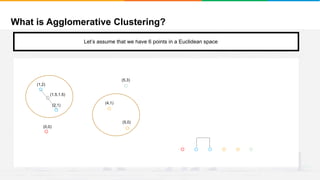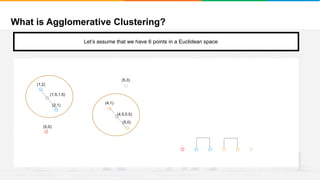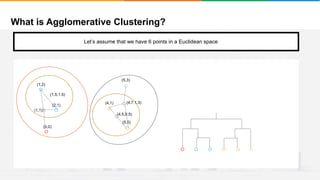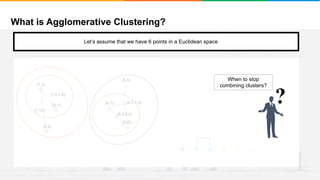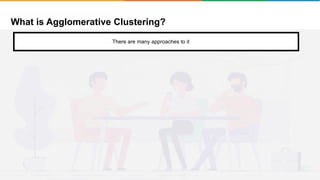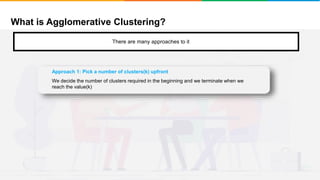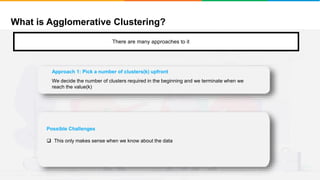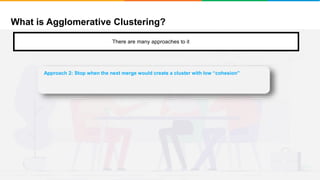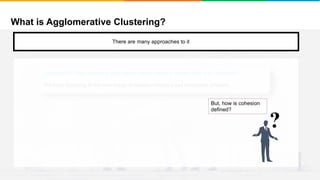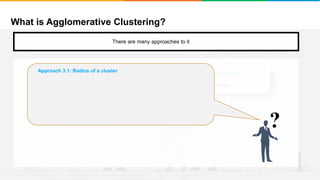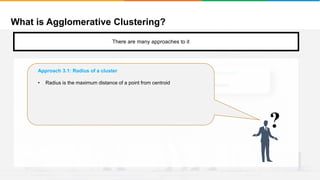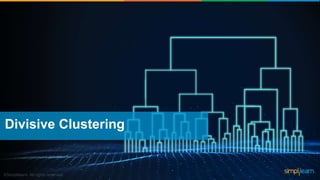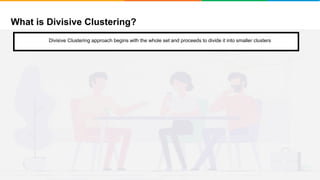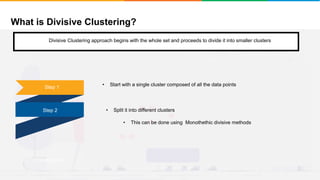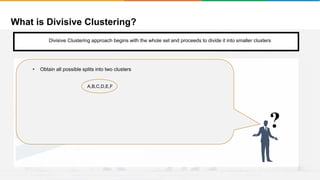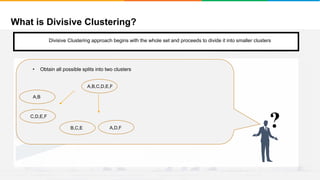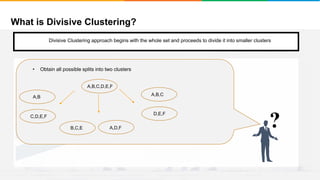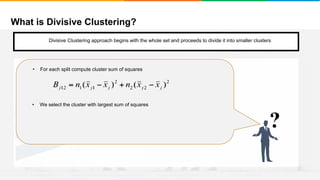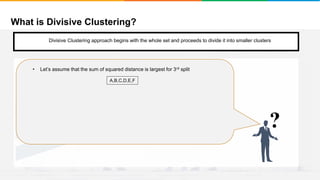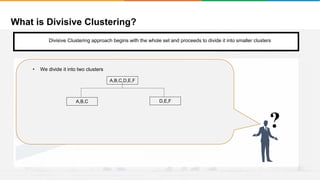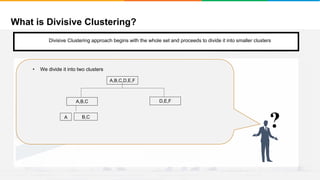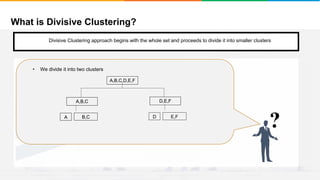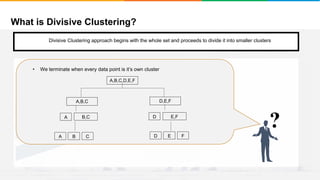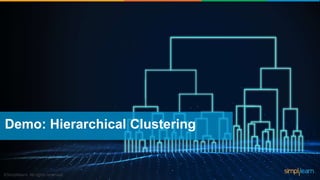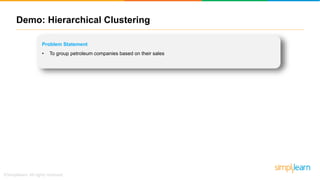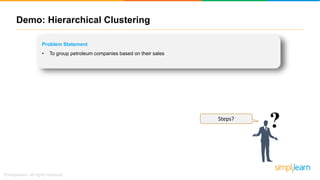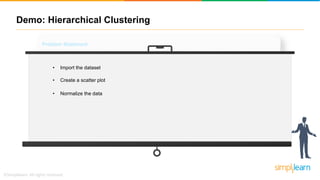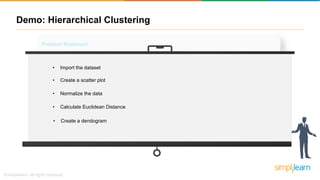Hierarchical Clustering | Hierarchical Clustering in R |Hierarchical Clustering Example |Simplilearn
- 2. What’s in it for you? What is Clustering? What is Hierarchical Clustering? How Hierarchical Clustering works? Distance Measure What is Agglomerative Clustering? What is Divisive Clustering?
- 4. What is Clustering? I have 20 places to cover in 4 days!
- 5. What is Clustering? How will I manage to cover all?
- 6. What is Clustering? You can make use of clustering by grouping the data into four clusters
- 7. What is Clustering? Each of these clusters will have places which are close by
- 8. What is Clustering? Then each day you can visit one group and cover all places in the group
- 10. What is Clustering? It will group places with least distance The method of dividing the objects into clusters which are similar between them and are dissimilar to the objects belonging to another cluster
- 11. What is Clustering? It will group places with least distance The method of dividing the objects into clusters which are similar between them and are dissimilar to the objects belonging to another cluster Partial Clustering Hierarchical Clustering
- 12. What is Clustering? It will group places with least distance The method of dividing the objects into clusters which are similar between them and are dissimilar to the objects belonging to another cluster Partial Clustering Hierarchical Clustering Agglomerative Divisive
- 13. What is Clustering? It will group places with least distance The method of dividing the objects into clusters which are similar between them and are dissimilar to the objects belonging to another cluster Partial Clustering Hierarchical Clustering Agglomerative Divisive K-means Fuzzy C-Means
- 14. What is Clustering? Applications of Clustering Customer Segmentation
- 15. What is Clustering? Customer Segmentation Insurance Applications of Clustering
- 16. What is Clustering? Insurance City Planning Applications of Clustering Customer Segmentation
- 18. What is Hierarchical Clustering? It will group places with least distance Let’s consider that we have a set of cars and we have to group similar ones together
- 19. What is Hierarchical Clustering? It will group places with least distance Hierarchical Clustering creates a tree like structure and group similar objects together
- 20. What is Hierarchical Clustering? It will group places with least distance The grouping is done till we reach the last cluster
- 21. What is Hierarchical Clustering? It will group places with least distance Hierarchical Clustering is separating data into different groups based on some measure of similarity
- 22. Types of Hierarchical Clustering It will group places with least distance Agglomerative It is known as Bottom-up approach
- 23. Types of Hierarchical Clustering It will group places with least distance Agglomerative Divisive It is known as Top Down approach
- 24. How Hierarchical Clustering works?
- 25. What is Hierarchical Clustering? Convergence 0 1 2 3 4 5 6 0 2 4 6 8 Y-Values P1P2 P3 P4 P5 P6 Termination Grouping Measure the distance • Let’s consider we have few points on a plane
- 26. What is Hierarchical Clustering? Convergence 0 1 2 3 4 5 6 0 2 4 6 8 Y-Values P1P2 P3 P4 P5 P6 Termination Grouping Measure the distance • Each data point is a cluster of its own
- 27. What is Hierarchical Clustering? Convergence 0 1 2 3 4 5 6 0 2 4 6 8 Y-Values P1P2 P3 P4 P5 P6 Termination Grouping Measure the distance • Each data point is a cluster of its own • We try to find the least distance between two data points/cluster
- 28. What is Hierarchical Clustering? 0 1 2 3 4 5 6 0 2 4 6 8 Y-Values P1P2 P3 P4 P5 P6 0 1 2 3 4 5 6 0 2 4 6 8 Y-Values P1P2 P5 P6 P3 P4 • The two nearest clusters/datapoints are merged together Termination Grouping Measure the distance
- 29. What is Hierarchical Clustering? 0 1 2 3 4 5 6 0 2 4 6 8 Y-Values P1P2 P3 P4 P5 P6 0 1 2 3 4 5 6 0 2 4 6 8 Y-Values P1P2 P5 P6 P3 P4 • The two nearest clusters/datapoints are merged together Termination Grouping Measure the distance P2 P1 • This is represented in a tree like structure called Dendrogram
- 30. What is Hierarchical Clustering? 0 1 2 3 4 5 6 0 2 4 6 8 Y-Values P1P2 P3 P4 P5 P6 0 1 2 3 4 5 6 0 2 4 6 8 Y-Values P1P2 P5 P6 P3 P4 • The two nearest clusters/datapoints are merged together Termination Grouping Measure the distance • This is represented in a tree like structure called Dendrogram P3P2 P1 P4
- 31. What is Hierarchical Clustering? 0 1 2 3 4 5 6 0 2 4 6 8 Y-Values P1P2 P3 P4 P5 P6 0 1 2 3 4 5 6 0 2 4 6 8 Y-Values P1P2 P5 P6 P3 P4 P5 P6 • The two nearest clusters/datapoints are merged together Termination Grouping Measure the distance • This is represented in a tree like structure called Dendrogram P5 P6P3 P4P2 P1
- 32. What is Hierarchical Clustering? 0 1 2 3 4 5 6 0 2 4 6 8 Y-Values P1P2 P3 P4 P5 P6 0 1 2 3 4 5 6 0 2 4 6 8 Y-Values P1P2 P5 P6 P3 P4 P5 P6 • The two nearest clusters/datapoints are merged together Termination Grouping Measure the distance • This is represented in a tree like structure called Dendrogram P5 P6P3 P4P2 P1
- 33. What is Hierarchical Clustering? 0 1 2 3 4 5 6 0 2 4 6 8 Y-Values P1P2 P3 P4 P5 P6 0 0.2 0.4 0.6 0.8 1 1.2 0 0.5 1 1.5 Y-Values P6 P3 P4 P6 • We terminate when we are left with only one clusters Termination Grouping Measure the distance P6P3P2 P1 P P5P4
- 34. What is Hierarchical Clustering? It will group places with least distance An algorithm that builds hierarchy of clusters 0 1 2 3 4 5 6 0 2 4 6 8 Y-Values P1P2 P5 P6 P3 P4 P5 P6 P2 P1 P3 P4 ? How do we measure the distance between the data points?
- 35. Distance Measure
- 36. Distance Measure Distance measure will determine the similarity between two elements and it will influence the shape of the clusters
- 37. Distance Measure Euclidean distance measure Distance measure will determine the similarity between two elements and it will influence the shape of the clusters
- 38. Distance Measure Euclidean distance measure Squared Euclidean distance measure Distance measure will determine the similarity between two elements and it will influence the shape of the clusters
- 39. Distance Measure Euclidean distance measure Manhattan distance measure Squared Euclidean distance measure Distance measure will determine the similarity between two elements and it will influence the shape of the clusters
- 40. Distance Measure Euclidean distance measure Manhattan distance measure Squared Euclidean distance measure Cosine distance measure Distance measure will determine the similarity between two elements and it will influence the shape of the clusters
- 41. Euclidean Distance Measure • The Euclidean distance is the "ordinary" straight line • It is the distance between two points in Euclidean space d=√ 𝑖=1 𝑛 ( 𝑞𝑖− )2 p q Euclidian Distance 𝑝𝑖 Option 02 Euclidean distance measure 01 Squared euclidean distance measure 02 Manhattan distance measure 03 Cosine distance measure 04
- 42. Squared Euclidean Distance Measure The Euclidean squared distance metric uses the same equation as the Euclidean distance metric, but does not take the square root. d= 𝑖=1 𝑛 ( 𝑞𝑖− )2 𝑝𝑖 Option 02 Euclidean distance measure 01 Squared euclidean distance measure 02 Manhattan distance measure 03 Cosine distance measure 04
- 43. Manhattan Distance Measure Option 02 Euclidean distance measure 01 Squared euclidean distance measure 02 Manhattan distance measure 03 Cosine distance measure 04 The Manhattan distance is the simple sum of the horizontal and vertical components or the distance between two points measured along axes at right angles d= 𝑖=1 𝑛 | 𝑞 𝑥− | p q Manhattan Distance 𝑝 𝑥 +|𝑞 𝑦− |𝑝 𝑦 (x,y) (x,y)
- 44. Cosine Distance Measure Option 02 Euclidean distance measure 01 Squared euclidean distance measure 02 Manhattan distance measure 03 Cosine distance measure 04 The cosine distance similarity measures the angle between the two vectors p q Cosine Distance 𝑖=0 𝑛−1 𝑞𝑖− 𝑖=0 𝑛−1 (𝑞𝑖)2 × 𝑖=0 𝑛−1 (𝑝𝑖)2 d= 𝑝 𝑥
- 46. What is Agglomerative Clustering? It will group places with least distance Agglomerative Clustering begins with each element as a separate cluster and merge them into larger clusters
- 47. What is Agglomerative Clustering? It will group places with least distance There are three key questions that needs to be answered How do we represent a cluster of more than one point?
- 48. What is Agglomerative Clustering? It will group places with least distance There are three key questions that needs to be answered How do we determine the nearness of clusters? How do we represent a cluster of more than one point?
- 49. What is Agglomerative Clustering? It will group places with least distance There are three key questions that needs to be answered How do we represent a cluster of more than one point? How do we determine the nearness of clusters? When to stop combining clusters?
- 50. What is Agglomerative Clustering? It will group places with least distance (1,2) (2,1) (0,0) (4,1) (5,3) (5,0) Let’s assume that we have 6 points in a Euclidean space
- 51. What is Agglomerative Clustering? It will group places with least distance (1,2) (2,1) (0,0) (4,1) (5,3) (5,0) Let’s assume that we have 6 points in a Euclidean space ? How do we represent a cluster of more than one point?
- 52. What is Agglomerative Clustering? It will group places with least distance (1,2) (2,1) (0,0) (4,1) (5,3) (5,0) Let’s assume that we have 6 points in a Euclidean space We make use of centroids which is the average of it’s points
- 53. What is Agglomerative Clustering? It will group places with least distance (1,2) (2,1) (0,0) (4,1) (5,3) (5,0) Let’s assume that we have 6 points in a Euclidean space
- 54. What is Agglomerative Clustering? It will group places with least distance (1,2) (2,1) (0,0) (4,1) (5,3) (5,0) Let’s assume that we have 6 points in a Euclidean space (1.5,1.5)
- 55. What is Agglomerative Clustering? It will group places with least distance (1,2) (2,1) (0,0) (4,1) (5,3) (5,0) Let’s assume that we have 6 points in a Euclidean space (1.5,1.5)
- 56. What is Agglomerative Clustering? It will group places with least distance (1,2) (2,1) (0,0) (4,1) (5,3) (5,0) Let’s assume that we have 6 points in a Euclidean space (1.5,1.5) (4.5,0.5)
- 57. What is Agglomerative Clustering? It will group places with least distance (1,2) (2,1) (0,0) (4,1) (5,3) (5,0) Let’s assume that we have 6 points in a Euclidean space (1.5,1.5) (4.5,0.5) (1,1)
- 58. What is Agglomerative Clustering? It will group places with least distance (1,2) (2,1) (0,0) (4,1) (5,3) (5,0) Let’s assume that we have 6 points in a Euclidean space (1.5,1.5) (4.5,0.5) (4.7,1.3) (1,1)
- 59. What is Agglomerative Clustering? It will group places with least distance (1,2) (2,1) (0,0) (4,1) (5,3) (5,0) Let’s assume that we have 6 points in a Euclidean space (1.5,1.5) (4.5,0.5) (4.7,1.3) (1,1)
- 60. What is Agglomerative Clustering? It will group places with least distance (1,2) (2,1) (0,0) (4,1) (5,3) (5,0) Let’s assume that we have 6 points in a Euclidean space (1.5,1.5) (4.5,0.5) (4.7,1.3) (1,1) ? When to stop combining clusters?
- 61. What is Agglomerative Clustering? It will group places with least distance There are many approaches to it
- 62. What is Agglomerative Clustering? It will group places with least distance There are many approaches to it Approach 1: Pick a number of clusters(k) upfront We decide the number of clusters required in the beginning and we terminate when we reach the value(k)
- 63. What is Agglomerative Clustering? It will group places with least distance There are many approaches to it Possible Challenges This only makes sense when we know about the data Approach 1: Pick a number of clusters(k) upfront We decide the number of clusters required in the beginning and we terminate when we reach the value(k)
- 64. What is Agglomerative Clustering? It will group places with least distance There are many approaches to it Approach 2: Stop when the next merge would create a cluster with low “cohesion”
- 65. What is Agglomerative Clustering? It will group places with least distance There are many approaches to it Approach 2: Stop when the next merge would create a cluster with low “cohesion” We keep clustering till the next merge of clusters creates a bad cluster/low cohesion
- 66. What is Agglomerative Clustering? It will group places with least distance There are many approaches to it Approach 2: Stop when the next merge would create a cluster with low “cohesion” We keep clustering till the next merge of clusters creates a bad cluster/low cohesion ? But, how is cohesion defined?
- 67. What is Agglomerative Clustering? It will group places with least distance There are many approaches to it Approach 2: Stop when the next merge would create a cluster with low “cohesion” We keep clustering till the next merge of clusters creates a bad cluster/low cohesion ? Approach 3.1: Diameter of a cluster • Diameter is the maximum distance between any pair of points in cluster
- 68. What is Agglomerative Clustering? It will group places with least distance There are many approaches to it Approach 2: Stop when the next merge would create a cluster with low “cohesion” We keep clustering till the next merge of clusters creates a bad cluster/low cohesion ? Approach 3.1: Diameter of a cluster • Diameter is the maximum distance between any pair of points in cluster • We terminate when the diameter of a new cluster exceeds the threshold
- 69. What is Agglomerative Clustering? It will group places with least distance There are many approaches to it Approach 2: Stop when the next merge would create a cluster with low “cohesion” We keep clustering till the next merge of clusters creates a bad cluster/low cohesion ? Approach 3.1: Radius of a cluster
- 70. What is Agglomerative Clustering? It will group places with least distance There are many approaches to it Approach 2: Stop when the next merge would create a cluster with low “cohesion” We keep clustering till the next merge of clusters creates a bad cluster/low cohesion ? Approach 3.1: Radius of a cluster • Radius is the maximum distance of a point from centroid
- 71. What is Agglomerative Clustering? It will group places with least distance There are many approaches to it Approach 2: Stop when the next merge would create a cluster with low “cohesion” We keep clustering till the next merge of clusters creates a bad cluster/low cohesion ? Approach 3.1: Radius of a cluster • Radius is the maximum distance of a point from centroid • We terminate when the diameter of a new cluster exceeds the threshold
- 73. What is Divisive Clustering? It will group places with least distance Divisive Clustering approach begins with the whole set and proceeds to divide it into smaller clusters
- 74. What is Divisive Clustering? It will group places with least distance Convergence Step 1 • Start with a single cluster composed of all the data points Step 2 Divisive Clustering approach begins with the whole set and proceeds to divide it into smaller clusters
- 75. What is Divisive Clustering? It will group places with least distance Convergence Step 1 • Start with a single cluster composed of all the data points • Split it into different clustersStep 2 Divisive Clustering approach begins with the whole set and proceeds to divide it into smaller clusters
- 76. What is Divisive Clustering? It will group places with least distance Convergence Step 2 Step 1 • Start with a single cluster composed of all the data points • This can be done using Monothethic divisive methods • Split it into different clusters Divisive Clustering approach begins with the whole set and proceeds to divide it into smaller clusters
- 77. What is Divisive Clustering? It will group places with least distance Convergence Step 1 • Start with a single cluster composed of all the data points • Split this into different clusters • This can be done using Monothethic divisive methods Step 2 ? What is monothetic divisive method? Divisive Clustering approach begins with the whole set and proceeds to divide it into smaller clusters
- 78. What is Divisive Clustering? It will group places with least distance Convergence Step 1 • Start with a single cluster composed of all the data points • There are two ways to do this 1. Monothethic divisive methods 2. Polythetic divisive methods ? A,B,C,D,E,F • Obtain all possible splits into two clusters Divisive Clustering approach begins with the whole set and proceeds to divide it into smaller clusters
- 79. What is Divisive Clustering? It will group places with least distance Convergence Step 1 • Start with a single cluster composed of all the data points ? • Obtain all possible splits into two clusters A,B,C,D,E,F C,D,E,F A,B Divisive Clustering approach begins with the whole set and proceeds to divide it into smaller clusters
- 80. What is Divisive Clustering? It will group places with least distance Convergence Step 1 • Start with a single cluster composed of all the data points • Split this into different clusters • There are two ways to do this ? • Obtain all possible splits into two clusters A,B,C,D,E,F A,D,F C,D,E,F A,B B,C,E Divisive Clustering approach begins with the whole set and proceeds to divide it into smaller clusters
- 81. What is Divisive Clustering? It will group places with least distance Convergence Step 1 • Start with a single cluster composed of all the data points • Split this into different clusters • There are two ways to do this 1. Monothethic divisive methods 2. Polythetic divisive methods ? • Obtain all possible splits into two clusters A,B,C,D,E,F A,D,F C,D,E,F A,B B,C,E Divisive Clustering approach begins with the whole set and proceeds to divide it into smaller clusters A,B,C D,E,F
- 82. What is Divisive Clustering? It will group places with least distance Convergence Step 1 • Start with a single cluster composed of all the data points • There are two ways to do this 1. Monothethic divisive methods 2. Polythetic divisive methods ? • For each split compute cluster sum of squares Divisive Clustering approach begins with the whole set and proceeds to divide it into smaller clusters
- 83. What is Divisive Clustering? It will group places with least distance Convergence Step 1 • Start with a single cluster composed of all the data points • There are two ways to do this 1. Monothethic divisive methods 2. Polythetic divisive methods ? • For each split compute cluster sum of squares • We select the cluster with largest sum of squares Divisive Clustering approach begins with the whole set and proceeds to divide it into smaller clusters
- 84. What is Divisive Clustering? It will group places with least distance Convergence Step 1 • Start with a single cluster composed of all the data points ? • Let’s assume that the sum of squared distance is largest for 3rd split A,B,C,D,E,F Divisive Clustering approach begins with the whole set and proceeds to divide it into smaller clusters
- 85. What is Divisive Clustering? It will group places with least distance Convergence Step 1 • Start with a single cluster composed of all the data points ? • We divide it into two clusters A,B,C A,B,C,D,E,F Divisive Clustering approach begins with the whole set and proceeds to divide it into smaller clusters
- 86. What is Divisive Clustering? It will group places with least distance Convergence Step 1 • Start with a single cluster composed of all the data points ? A,B,C D,E,F A,B,C,D,E,F Divisive Clustering approach begins with the whole set and proceeds to divide it into smaller clusters • We divide it into two clusters
- 87. What is Divisive Clustering? It will group places with least distance Convergence Step 1 • Start with a single cluster composed of all the data points ? A,B,C D,E,F A B,C A,B,C,D,E,F Divisive Clustering approach begins with the whole set and proceeds to divide it into smaller clusters • We divide it into two clusters
- 88. What is Divisive Clustering? It will group places with least distance Convergence Step 1 • Start with a single cluster composed of all the data points ? A,B,C D,E,F A B,C A,B,C,D,E,F A,B,C D,E,F A B,C D E,F A,B,C,D,E,F Divisive Clustering approach begins with the whole set and proceeds to divide it into smaller clusters • We divide it into two clusters
- 89. What is Divisive Clustering? It will group places with least distance Convergence Step 1 • Start with a single cluster composed of all the data points ? A,B,C D,E,F A B,C D E,F A B C A,B,C,D,E,F Divisive Clustering approach begins with the whole set and proceeds to divide it into smaller clusters • We divide it into two clusters
- 90. What is Divisive Clustering? It will group places with least distance Convergence Step 1 • Start with a single cluster composed of all the data points ? • We terminate when every data point is it’s own cluster A,B,C D,E,F A B,C D E,F A B C D E F A,B,C,D,E,F Divisive Clustering approach begins with the whole set and proceeds to divide it into smaller clusters
- 92. Demo: Hierarchical Clustering Problem Statement • To group petroleum companies based on their sales
- 93. Demo: Hierarchical Clustering Problem Statement • To group petroleum companies based on their sales ?Steps?
- 94. Demo: Hierarchical Clustering Problem Statement • To group petroleum companies based on their sales Steps? • Import the dataset
- 95. Demo: Hierarchical Clustering Problem Statement • To group petroleum companies based on their sales Steps? • Create a scatter plot • Import the dataset
- 96. Demo: Hierarchical Clustering Problem Statement • To group petroleum companies based on their sales Steps? • Create a scatter plot • Import the dataset • Normalize the data
- 97. Demo: Hierarchical Clustering Problem Statement • To group petroleum companies based on their sales Steps? • Create a scatter plot • Import the dataset • Normalize the data • Calculate Euclidean Distance
- 98. Demo: Hierarchical Clustering Problem Statement • To group petroleum companies based on their sales Steps? • Create a scatter plot • Import the dataset • Normalize the data • Calculate Euclidean Distance • Create a dendogram
- 99. Demo: Hierarchical Clustering Problem Statement • To group petroleum companies based on their sales Steps? • Create a scatter plot • Import the dataset • Normalize the data • Calculate Euclidean Distance • Create a dendogram • Cluster into groups
- 100. Demo: Hierarchical Clustering Problem Statement • To group petroleum companies based on their sales Steps? • output
- 101. So what’s your next step?
- 102. So what’s your next step?
Editor's Notes
- Style - 01
- Style - 01
- Style - 01
- Style - 01
- Style - 01
- Style - 01
- Style - 01
- Style - 01
- Style - 01
- Style - 01
- Style - 01
- Style - 01
- Style - 01
- Style - 01
- Style - 01
- Style - 01
- Style - 01
- Style - 01
- Style - 01
- Style - 01
- Style - 01
- Style - 01
- Style - 01
- Style - 01
- Style - 01
- Style - 01
- Style - 01
- Style - 01
- Style - 01
- Style - 01
- Style - 01
- Style - 01
- Style - 01
- Style - 01
- Style - 01
- Style - 01
- Style - 01
- Style - 01
- Style - 01
- Style - 01
- Style - 01
- Style - 01
- Style - 01
- Style - 01
- Style - 01
- Style - 01
- Style - 01
- Style - 01
- Style - 01
- Style - 01
- Style - 01
- Style - 01
- Style - 01
- Style - 01
- Style - 01
- Style - 01
- Style - 01
- Style - 01
- Style - 01
- Style - 01
- Style - 01
- Style - 01
- Style - 01
- Style - 01
- Style - 01
- Style - 01
- Style - 01
- Style - 01
- Style - 01
- Style - 01
- Style - 01
- Style - 01
- Style - 01
- Style - 01
- Style - 01
- Style - 01
- Style - 01
- Style - 01
- Style - 01
- Style - 01
- Style - 01
- Style - 01
- Style - 01
